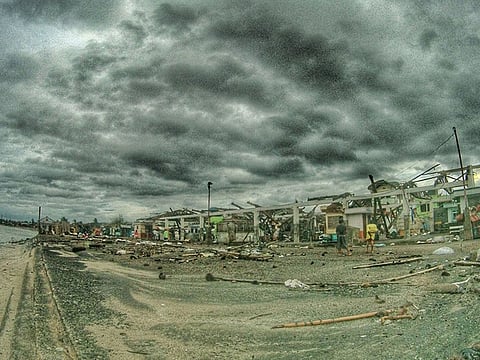How towns were turned into howling wilderness
Victims appeal for emergency shelters as thousands of houses ripped up

December 18, Day 4 (1pm)
Magallanes, Sorsogon, Philippines: Residents who have lost their houses are appealing for emergency shelters four days after supertyphoon Melor, with an equivalent of Category-4 hurricane force, wrought havoc on their communities.
Augusto Tito Mella Ragragio, the mayor of this town where 6,300 families lost their houses, sought outside help to build temporary shelters for the typhoon victims.
Appeal for emergency goods:
-
Canvas/plastic sheets (emergency shelter)
-
Nails (assorted sizes)
-
Galvanised Iron (GI) sheets
-
Plywood
-
Solar power kits
-
LED lights / lanterns
-
Food packs
Melor (local code Nona), made landfall in eastern Philippines on December 14 from the Pacific. It has since weakened into tropical storm after moving into the West Philippine Sea.
Meanwhile, over 878 mm of rain fell in the Visayan Sea, while relentless showers were dropping rain at a rate of over 50 mm per hour off the northeastern coast of Luzon, according to Nasa's tropical Rainfall Measuring Mission.
December 17, Day 3 (8pm)
Truck loaded with 1,500 food packs from the Department of Social Welfare and Development (DSWD) regional office in Legaspi City had been delivered to Magallanes, one of the hardest-hit towns.
The packs include 6-kg rice, four cans of sardines, four cans of corned beef, six sachets of three-in-one coffee (based on the report of DSWD Bicol Regional Rirector Arnel B. Garcia).
December 17 (2pm)
Bulan, Sorsogon, Philippines: Supertyphoon Melor has reduced vast swathes of central and eastern Philippines into a virtual wasteland, social media posts reveal.
Until recently, this part of Bicol peninsula is known for having some of Asia's most unspoilt and picturesque whitesand beaches amidst active volacoes and an active communist insurgency.
Now, groteque images show roofs ripped out of concrete buildings, thousands of homes made of light materials strewn on the ground, schools torn apart and acres of coconut farmlands laid waste.
The typhoon, locally known as Nona, barrelled in from the Pacific on Monday afternoon, had lso caused widespread flooding across the northern and central regions and dumped heavy rain on the sprawling capital of Manila.
Residents, meanwhile, have started picking up the pieces of their torn-down homes after gusts of up to 170kph left a massive damage to agriculture and property in its wake.
As the full extent of the devastation starts to emerge, there’s one little upside: despite the massive devastation to property, people are grateful for the minimal casualties – just five in total in Sorsogon, a province with an estimated 740,000 inhabitants.
In Albay (home to a much bigger population of 1.23 million), pre-emptive evacuation helped keep the death toll to a zero, according to Albay Governor Joey Salceda.
But many who saw their homes and livelihood totally wrecked and don’t know where to start -- are now appealing for help from neighbours and the national government.
Three days after the devastation, roads are just starting to be cleared and internet lines remain spotty, or non-existent.
Damage to property and agriculture is so extensive, running into at least Php4 billion (about $100 million) in Sorsogon alone, according to initial estimates of the local Disaster Risk Reduction and Management Council (DRRMC).
As food and drinking water supplies run in short supply and local government units -- the first responders-- are overwhelmed, residents are bracing for dark holidays and long-term recovery.
Officials said power won’t be restored for weeks, if not months.
Melor unleashed its fury about 200km north of the Leyte, which bore the brunt of the deadly Haiyan supertyphoon in 2013. This time, the provinces of Samar and Sorsogon were the hardest hit.
Delivery of aid and relief good is also a challenge. Sorsogon does not have its own functioning airport (there’s one unfinished airport in Bulan, whose construction had only been restarted this year).
Heavy-lift aircraft can only land in Albay, about 90 minutes by car from the remote sea-side towns of Sorsogon, like Bulan, Matnog, Gubat, Barcelona, Irosin, Juban, Bulusan and Magallanes – towns around an active volcano that sustained the most severe damage.
Sign up for the Daily Briefing
Get the latest news and updates straight to your inbox



